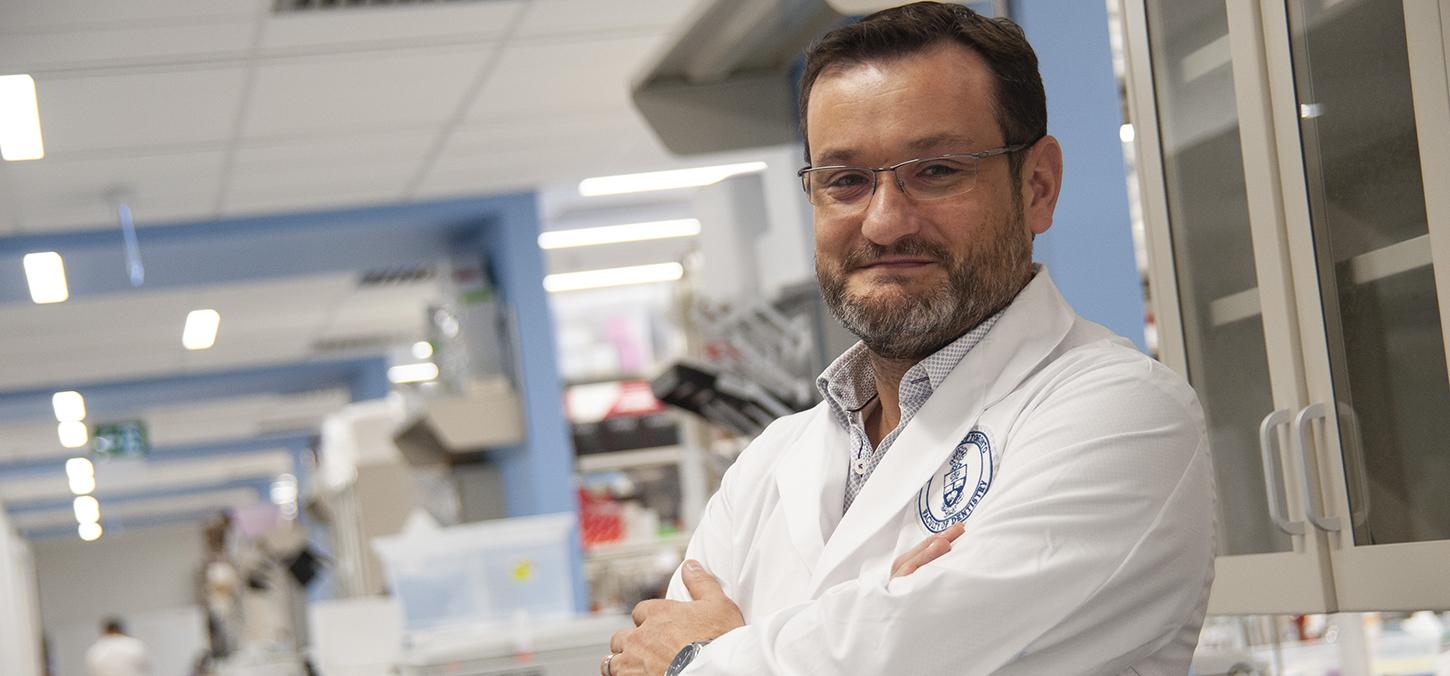
Meet Dentistry’s “Biophysicist,” Laurent Bozec
What do physics, the Faculty of Dentistry, and the head of Henri IV of France all have in common?
The answer is “biophysicist” Laurent Bozec, Dentistry’s newest associate professor of dental sciences.
Bozec, who began on November 1st, comes to UofT by way of University College London’s (UCL) Eastman Dental Institute, where he was Head of Research, and Director (and founder) of the Eastman Centre for Postgraduate Research. In the QS World University Rankings by Subject 2017, the Institute is ranked 6th in the world for Dentistry; UCL is ranked 7th in the world overall.
At the Eastman, Bozec has been tackling health challenges related to ageing, connective and mineralised tissue disorders, and bacteriology. He works towards translating diagnostic approaches to a number of pathologies ranging from skin conditions to dental caries. And he does so by looking at the biophysical properties of tissues and molecules, via atomic force microscopy, at the unfathomably small scale of 1/1,000,000 metres.
Feeling is better than seeing
Atomic force microscopy’s imaging works at the nanoscale, where the principles of optics no longer apply. But you can still feel molecules or tissues, says Bozec. You can poke them, stick them, put them onto a surface and then peel them off, all of which gives scientists information on the properties of these surfaces or the cells.
Picture the way a record player works: the stylus (the turntable’s needle) glides over the grooved surface of a vinyl record to emit music.
Atomic force microscopy follows much the same principle, says Bozec, only it shrinks the stylus of a record player to a scale infinitesimally thinner than a strand of human hair. (The tip of the stylus is typically around 10 to 20 nanometres in diameter; put into perspective: one million nanometres equals one millimetre). When pressed against surfaces, researchers are able to record how the microscope’s probe glides up and down, granting them access to “the molecular structure of virtually anything,” Bozec says.
So just how does “feeling” molecules and tissues translate to solving important problems in human health?
Imagine attaching live bacteria cells to the end of the probe and pressing it to a surface until it sticks. That surface could be enamel (as in, a human tooth), as one example, or titanium (as in, an implant surface).
“Then you have a very early basis of an infection mechanism,” says Bozec, and by understanding the nature of that “intimate interaction between the surface molecules on a cell and the surface such as a tooth or skin, we can develop strategies to either promote or prevent this interaction.”
Over the years, the main thrust of Bozec’s research has involved collagen, one of the fundamental building blocks of the body (also a main component of skin and the insides of your teeth). Back at the Eastman, Bozec and his team were looking for biomarkers for aging skin using the same approach (Bozec has conducted research in collaboration with Loreal). Another application of the research looks at the effects of whitening products on the inner health of your teeth.
Novel Applications
Yet, the applications for this type of imaging are virtually endless, and Bozec has expanded his portfolio far beyond human and oral health. He’s worked with the European researchers consortia, funded by the European Union under the H2020 program, to apply his imaging techniques to the conservation of historical objects such as parchment and canvasses.
“The types of samples and materials are different,” he says, “but the methods, understanding, and physics: it’s exactly the same approach.”
Recently, Bozec, who at one point worked on the leather binding from Darwin’s notebook, turned his love of culture to more organic objects. He was invited to use some of his novel approaches to help settle a debate between two groups of scientists regarding the authenticity of the severed head of France’s King Henri IV (conflicting papers on the identity of the head were published in top science journal Nature).
“[Working on one of the most famous kings in France] turned out to be such a unique and humbling experience, fulfilling one of my academic goals,” says Bozec.
Henri was assassinated in 1610 and posthumously beheaded during the French Revolution. The head — identifiable only by a mole on the nose and a jaw injury from a 1594 assassination attempt — disappeared during the French Revolution, only to resurface years later.
Clinical collaborations
Born and raised in France, bilingual Canada was a “natural fit” for Bozec and his family, as well as the “vibrant, motivated” people at UofT.
But a major draw for his emigration, says Bozec, is the collaborative and multidisciplinary research conducted at Dentistry and across UofT. Proximity to some of Canada’s premiere research hospitals, and the Faculty’s many clinicians, was a necessity for Bozec.
“Working in the Faculty of Dentistry is a huge asset for any scientist like myself as we have access to a huge pool of clinicians and specialists. As basic scientists, it is our duty to reach out to clinicians, to understand what our colleagues who treat patients on a daily basis need in terms of research expertise before we can jointly work together.” he says. “Over the year, I have been fortunate to work with incredible clinicians and I am very much looking forward building bridges here in Toronto and across Canada.
For Bozec, the translation of his research — helping people — is his main motivator. “Academic Research is becoming increasingly more and more translational. The faculty of Dentistry has already an impressive portfolio of translational research and I am very eager to join this exciting environment”
And as for Henri’s head? “I’ll let you know when the paper’s written,” he replies with a smile.